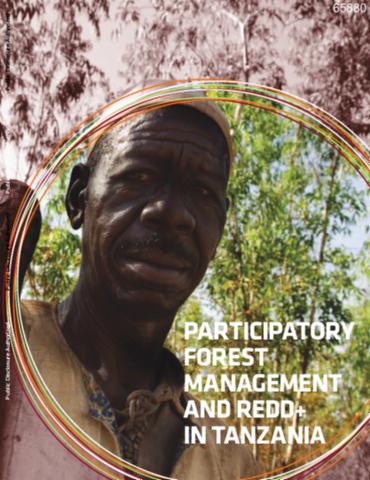REDD+ and Community Forestry
This publication is the result of an initiative to promote an exchange between Brazil and African countries on lessons learned about the role of community forestry as a strategic option to achieve the goals of Reducing Emissions from Deforestation and Forest Degradation (REDD+). The initiative was supported by the World Bank with funding from the Global Environment Facility (GEF), and coordinated by the Amazonas Sustainable Foundation (FAS) with support from the National Forestry Agency International (ONFI).
Participatory Forest Management and REDD+ in Tanzania
Tanzania's land, local government and forest laws mean that rural communities have well defined rights to own, manage and benefit from forest and woodland resources within their local areas through the establishment of village forests. This approach, known by practitioners as Community Based Forest Management (CBFM) results in the legal establishment of village land forest reserves, community forest reserves or private forests. By 2008, 1,460 villages on mainland Tanzania1 were involved in establishing or managing village forests covering a total of over 2.345 million hectares.
Regulation on supervision over the elaboration of the forestry fundamentals.
This Regulation hereby prescribes the mandatory supervision rules, aimed at the control over the execution of the preparation of forest-economic documents or plans (for private and state owned forests).Forest-economic planning documents are projects assignment for the preparation of the forest-economic basis, including the classification of forests and forest land in ecological-productive terms, with the aim of determining the technical objectives of forest management (such as creation of spatial units, the marking of their boundaries in the field, the recording of boundaries and their mapp
Land Reform (Scotland) Act 2016 (2016 asp 18).
This Act brings about a comprehensive reform of the law relating to land rights and land planning and management in Scotland.
Restrictions on Acquisition of Immovables Act (2012)
The Act provides the restrictions on the acquisition of immovables used as profit yielding land arising from public interest and the restrictions on the acquisition of immovables arising from national security reasons. For the purposes of the Act, public interest is, in particular, development of the management for specific purposes and sustainable management of immovables used as profit yielding land which contain agricultural and forest land.
Jamaica National Environmental Action Plan 1999-2002. .
The Jamaica National Environmental Action Plan (JANEAP) is a national Plan with a multi-sectoral approach. The duration of the Plan is 3 years between 1999 and 2002. The main objective of the Plan is to ensure good environmental planning and management to contribute to the sustainable development.Regarding the biological resources, forestry, watershed management, protected areas and oceans the Plan provides for different actions to be taken. A Fisheries Management Plan and an Ocean and Coastal Zone Policy will be prepared and implemented.
Regulation to the Community Rights Law with Respect to Forest Lands (as amended).
This Regulation of the Forestry Development Authority (FDA) implements provisions of the Community Rights Law of 2009 with Respect to Forest Lands ("Community Rights Law"), and determines the rules, guidelines and procedures for the establishment of authorized forest communities and to access, manage, use and the benefits of forest resources within the Republic of Liberia, and participation by communities in the reforestation, rehabilitation and conservation of forest and wildlife resources in Liberia.
National Policy on Forests 1997.
The National Policy on Forests developed by the Ministry of Environmental Protection, Natural Resources and Forestry is a nation-wide sectoral document for designating the complex of actions shaping relations between humankind and forests, with the aim of preserving the conditions for the indefinite maintenance of the multi-functionality of forests, their multi-faceted utility and protection and their role in the shaping of the natural environment, in line with the present and future expectations of society.
Forest Resource Conservation Act, 1992 (No. 47 of 1992).
This Act provides with respect to the management and conservation of forest resources in Saint Vincent and the Grenadines. It also provides for the protection of water resources present in forest areas and lease of forest land.
Climate Change Act 2017.
The purpose of this Act, consisting of 102 sections divided into 11 Parts and completed by one Schedule, is to repeal and re-enact with amendments the Climate Change Act 2010: a) to set a long-term greenhouse gas emissions reduction target; b) to provide for the setting of 5-yearly interim greenhouse gas emissions reduction targets in order to reach the long-term greenhouse gas emissions reduction target; c) to facilitate the consideration of climate change issues in specified areas of decision making of the Government of Victoria; d) to set policy objectives and guiding principles to infor




